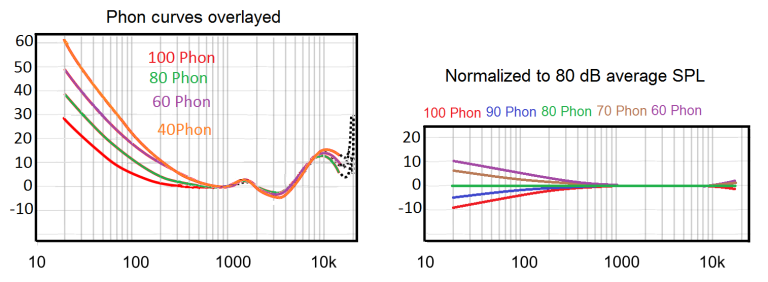Diffuse field is incorrect compensation for headphones. This is why O-W started developing their own compensation curve and added the bass enhancement. That extra bass is needed for several reasons. Not everyone, however, needs the same amount of extra bass. This is for several reasons such as age, gender, people listening at lower SPL (here is where equal loudness contours comes in) and preference or people have gotten used to an incorrect reference (speakers with a substantial room-induced) bass boost. O-W compensation lows compensation is based on this.
Pinna effects with DF correction are incorrect for headphones. Also corrections for speakers from in front of you are incorrect.
Also measuring at ones own eardrum is incorrect.
What one needs to know is what the actual driver produces. Not what a 'standard' Pinna and earcanal CHANGE and then subsequently use an incorrect 'correction' based on measurements that differ substantially from an actual headphone situation and then claim it should be done this or that way because a 'standard' tells them to.
A standard is fine if one want to peer review and come to a similar 'result' when measuring acc. to a standard.
But what if the standard is 'off' because the used standard has is not obtained using a standard 'headphone' but based on multiple speakers with certain angles and distances that do not resemble anything like a headphone situation ?
If that were the correct method all headphones measured and EQ'ed would sound exactly the same and I guess we all know they don't.
Yeah, I know the HRTF is blamed because all Pinnae differ. Here is the thing though. When we hear a music (live or otherwise) we never hear it from the side of us. We always here it from in front of us and that's where the Pinna (HRTF in total actually) makes the most difference.
The FR is modified differently when coming from the sides.
Sound from the side is going directly into the ear canal, partially blocked by the Tragus. Look at ears from the side and some Tragus are totally blocking the ear canal and some only partially. This is driver size and diameter dependent as well.
This is where our friend Griesinger comes along and hands us a method where that actually is taken into account. Measurements won't.
With measurements you can (at least the way I measure) actually measure what comes from the driver.
One can argue what kind of 'correction' that needs. Measuring a driver through a bunch of narrow bandfilters (acc to a standard) and 'correcting' them partially with other 'standards' that have no relevance to mimic a headphone isn't exactly the way to go about it. When you want to know what the driver does, measure it's output at the same distance as an ear canal and use the same kind of damping around the microphone as the skin dies.
You are aware that Tyll, from day one because he got incorrect advise, had a completely wrong 'correction' in place. Headroom later made better 'corrections' available. The raw measurements can be used IF you know exactly how these should be compensated. His HATS requires different compensation from what O-W uses so you need to get an exact (and correct for headphones) compensation, which AFAIK, has never been made.
A year before he retired he played with his HATS at Harman to find out what compensation he actually needed.
However, he really didn't want to revisit all of his measurements and as so many 'old (and incorrect) ínfo was already out there he couldn't come up with very different, but correct, FR plots.
You can still use IF plots as comparisons between his measured headphones where you can compare to known (to the listener) headphones.
I believe Jaako uses Tyll's raw plots and applies a different correction. But as I already mentioned, a HATS is not really suited to measure headphones. They are fine for other applications for which the actual 'compensations' are designed.
About scales of plots:
I know there are standards for plots. However, these have too small dB scales which make them seem 'flatter' than they sound to me.
So, again against conventions and standards, made my own 'standard'. Just because I measure headphones for myself and to get correct EQ not so one can overlay with 'standards'.
I mean the bottom plot seems to be a lot 'better' than the one above it, doesn't it ?
But if I wanted to EQ to it the upper one tells me more about how it actually sounds and what compensation is needed. This, to me, is far more important than meeting a standard (which I don't consider a real standard)
For electronics and speakers things are different. Certainly for electronics the standards are holy for numerous reasons. Measuring headphones is still in its infancy so I feel it is only fair to make my own 'thing' which is no standard by lack of a real standard.
I mean, overlay ALL measurements of the same headphone made by different folks... they all differ and sometimes well over 10dB.
There is no REAL standard, there are some folks that bombarded something to a (their) standard. Its not the same as an actual standard.








